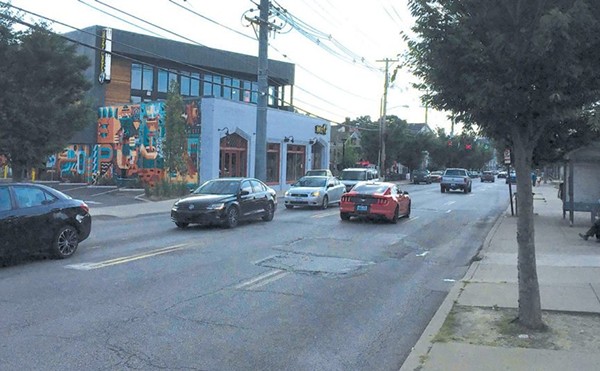The greening of brownfields is an unavoidable step on the road to an eco-friendly city.

But none of the optimistic, technical presentations helped a situation just two miles away in the Irish Hill neighborhood, where a dispute over plans to revamp an old industrial site has emotions running high.
Nobody has spoken out against the development by Poe Companies, which would turn a former warehouse and recycling plant site into 30 acres of office and commercial buildings, one-third of which would be green space. Neighbors have been looking for a way to have the eyesore cleaned up, visible at the moment mainly through the diamonds of a chain-link fence.
But they say the proposed project is too big and too suburban, not befitting the character of the nearly 150-year-old neighborhood.
What’s more, Poe wants to reroute and straighten a portion of Beargrass Creek, which jogs along the perimeter of the property. The proposed changes would remove about 400 feet of the creek, which is 400 feet too many for residents who argue that the decision is based on an incomplete study, where industrial infrastructure — like a small bridge — thought to affect the creek’s flow, particularly during flooding, was not considered.
Altering the creek requires myriad approvals from agencies, including the Army Corps of Engineers, the State Division of Water and the Metropolitan Sewer District. There is a conventional order to the permit process. In this case, the decision the Army Corps issues — whether Poe can reroute the creek — is the project’s lynchpin.
But two weeks ago, MSD granted the developer permission to build on the floodplain that occupies a portion of the site, despite the fact that the Army Corps may still be months away from making a decision.
“Ideally what you want to do is avoid spending money and also wasting agency and public time by going for the (Army Corps) permit that, in this case, is the key permit,” said Tom Fitzgerald, attorney for the Irish Hill Neighborhood Association.
He said the law is generally on the side of those who want to keep natural waterways unchanged, encouraging developers to seek other options, including choosing a different site altogether.
“There is a presumption that there are other alternatives available because this isn’t a water-dependent activity,” he said.
In December 2005, Stephen Lutz, planning supervisor at Metro’s department of planning and design, seems to have agreed that Army Corps certification should come before MSD granted a flood plain variance necessary for building on the site.
“I suggest that Corps approval come first, given that they are having to relocate the creek,” Lutz wrote in an e-mail to the neighborhood association. “This seems a pretty major requirement, and could impact their site plan significantly.”
Yet last month, after what some in attendance felt was a suspiciously brief hearing, MSD approved a floodplain variance — a portion of the overall permission it must give, which is likely more than a year away — for the project without Army Corps approval. Notes of discord have rung since the beginning of the project, which Poe project development manager Eric Goodman said has been amended more than once in accordance with feedback from neighbors and specialists.
But Poe’s application for a floodplain variance, out of order, so to speak, raised a red flag among neighbors. MSD’s approval of the variance last month has led to accusations that it was a done deal, and some now worry that the entire project might be.
The federal Clean Water Act indicates that the natural landscape of an area should be the first concern against which all other decisions are measured. Certainly, the most vocal members of the neighborhood association agree.
Five years ago, Irish Hill spent about $20,000 to create a neighborhood plan, which includes a plan for this site that did not require rerouting the creek. But after more than two years of meetings, surveys and correspondence, neighbors still don’t think Poe has gotten it right, says Lisa Dettlinger, the IHNA secretary who has been outspoken about this development.
Goodman chafes at accusations that the company has tried to circumvent any part of the approval process, instead commending company president Steve Poe for moving quickly to develop a spot that will require so much cleanup.
“I’m a landscape architect, I’m a green guy. I enjoy green work that betters the community,” Goodman said. “It’s frustrating as a developer to know that you’re doing something positive on a contaminated site, on a blight. I thought in the beginning that neighbors would be happy about it.”
Dettlinger is also surprised at the impasse.
“I love my house, it’s worth protecting. The neighborhood is worth making a better neighborhood,” she said. “And I didn’t want this to be a fight, this development. I was just hoping that — I don’t know, I was just hoping this would be easier.”
Contact the writer at
[email protected]





